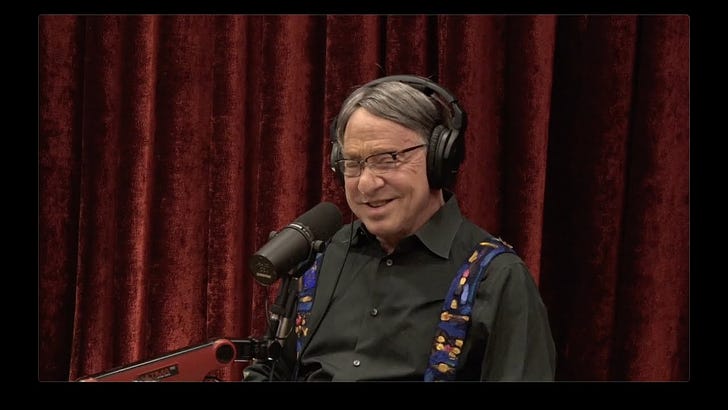Q2 2024 Backtest Portfolio
The Q2 2024 backtest portfolio made ~$4 million (annualized), had a profit factor of 2.78, and a return on minimum starting value of 382%.
Important: There is no guarantee that these strategies will have the same performance in the future. I use backtests to compare historical strategy performance. Backtests are based on historical data, not real-time data so the results we share are hypothetical, not real. There are no guarantees that this performance will continue in the future. Trading futures is extremely risky. If you trade futures live, be prepared to lose your entire account. I recommend using these strategies in simulated trading until you/we find the holy grail of trade strategy.

We’re on the hunt for the holy grail of automated trade strategy. There are over 80 strategies on ATS. Each one provides a technique or a tactic for a market set up that can be (and has been) automated.
There are many different types of strategies. Some include a risk management plan; some only make long trades; some should only be traded with metal futures; while others should only be traded with equities. There are scalping strategies, high win rate strategies, gap strategies, momentum strategies and even AI generated strategies.
Every few months I like to climb the highest tree in search of a broader view of the HUNT. In particular, I like to review:
where we’ve come from,
where we are now; and,
where we’re going to from here.
So, how far have we come? I think we’ve come a long way. Here’s a list of past updates to help answer that question:
ATS also published the following strategies:
Each strategy has its own universe of variation as well. You can either download the strategy or recreate it based on the steps provided in the strategy description.
I’ve also added ~55 strategies/variations to the forward test, most of which are other instruments on strategies that have already performed well.
I also started our first Live Test in January. I’m currently up $18K. It’s been a bumpy ride. Here’s an updated p/l:
After an account high of $32K on Day 13, I lost $8,500 on Day 14. A few changes to the strategy selection process were made and I’m crawling my way back to where I was on Day 14. You can read about changes made in the updates below:
The biggest takeaway in terms of strategy selection is that instead of selecting 20 strategies to trade, I’m only trading a few strategies and their variations. The goal at this point is to be able to speak to the performance of a few strategies, not the selection process.
When we first started, I often asked the question: is the holy grail static or a moving target? It is this question that inspired the first Mudder Report. I’ve come to believe that the answer is both, which is a good thing for our hunt. A static holy grail exists, but generally offers few trades throughout the year—I’ve seen this animal. A “truer” static holy grail would make 1 to 2 trades a day—that unicorn I have never laid eyes on.
A “moving target” is a much easier hunt; you can use a portfolio of automated trading strategies that only make rare trades or you can use a strategy that is currently outperforming others. I’m using both approaches in the current live test.
Now I want to take a few minutes to talk about the results of the Q2 backtest, which is based on optimizations from January to March of this year. This is over a shorter time period than the Q1 2024 Backtest, which is based on optimizations from December 2022 to December 2023. ATS Subscribers, scroll to the bottom of this page to view the full version of each, which includes the instrument and data series used along with any updated parameter notes.
What’s happening to the backtest portfolio?
In Q4 of 2023, the backtest portfolio made ~$2.5 million, had a profit factor of 2.19 and a return on minimum starting equity of 421%. Minimum starting value is calculated by adding 25% (as a cushion of protection) to the maximum draw-down.
The Q1 2024 backtest portfolio made ~$3.5 million, had a profit factor of 2.10 and a return on minimum starting equity of 466%.
The Q2 2024 backtest portfolio made ~$4 million (annualized), had a profit factor of 2.78, and a return on minimum starting equity of 382%.
In total, and when annualized, this backtested portfolio made:
~10k trades (~41 trades per day and ~$418 per trade); compared to
~6k trades (~23 trades per day and ~$577 per trade); in Q1 of 2024
~9k trades (~34 trades per day and ~$290 per trade) in Q3 of 2023;
~8k trades (~32 trades per day and ~$257 per trade) in Q2 of 2023; and,
~24k trades (~94 trades per day and ~$219 per trade) in Q1 of 2023.
So we have a higher profit factor, but a lower $/trade. The average time in market is 406 minutes and the largest losing trade on average is $1,044. The highest net profit comes from Strategy 7 run on BTC (bitcoin), which made $65K in 3 months on 29 trades, and has a profit factor of 5.75. Strategy 15 (BTC), AI Strategy 13 (NQ), and AI Strategy 14 (NQ) made $4,804, $5,543, and $4,385 in net income per trade, respectively.
I also want to point out that the Q2 2024 backtest covers a 3-month period rather than a 1-year period so the numbers above are annualized. I am running both the Q1 1 year backtest and the Q2 3 month backtest in the forward test (live data using simulated accounts) to see if one performs better than the other. To date, the difference has been negligible, but I also need to do a better job of tracking different strategy variations.
I've also added a few new columns to this performance review including MAE, MFE and ETD. The average MAE, MFE and ETD in the portfolio is $588, $1,192 and $581. What do these metrics mean? In a nutshell, MAE, MFE and ETD are different legs of a trade. You’ve got the down leg (MAE), the up leg (MFE) and the retrace (ETD). Ideally, you want to minimize the percentage of both the down leg and the retrace on the up leg. So I like to look at MAE and ETD as a percentage of MFE. If you add the two together you can look at the lowest percentage as the most efficient strategy. The best (lowest) ratios go to Strategy 81_long, 78v1, AI_14, AI_13, and 71_equities. Click here for an overview of these metrics from an earlier post.
A quick word on the economy
Here’s a look at how I see the current trend continuing into 2024 technically. This is a daily chart of the NQ. In other words, each bar represents a day.
As you can see, last week we bounced off of the supporting trendline for a second time. We’re either going to see a nice rally here or it could break support. I’m doubtful of the latter because despite 5% on 2yr treasuries, there’s still a lot of dry powder out there and it wants more than a 5% return.
As I predicted last year, the business community is still begging for lower rates, and the Fed is still unrelenting, but folks are getting smarter and starting to realize that we’re almost half way through the year with no rate cuts.
Last week Powell doubled down on 2% as a target stating several times to the press core that “We will reach 2%.” That said, there was something different about Powell’s confidence this time. He looked sickly and was coughing a lot. I suppose the man could have just had a cold. No doubt he was taken off guard when the second question of the day from a WaPo reporter asked him if he had any ‘regrets in hindsight’—ouch. To Powell’s credit, he did say that the decision to lower rates would be left to PCE, but he also said that rates would likely decrease this year. The question is, for such an influential number, why say anything if you don’t know? Poor Powell.
ATS Research
Well, we’re 82+ strategies in and it’s time to reflect. It took some time to gather enough data to make the transition, but I think we’re there. I want to start taking a closer look at the data. I’ll be publishing that research in ATS Research. ATS Research is a newsletter within ATS, but you can also subscribe to ATS Research separately.
As we get more into this transition, I want to anchor the research on figuring out what works. In the way of Renaissance Technologies, the question we’re asking in ATS Research isn’t ‘why does something work’, but ‘what works’. In other words, if I’m trying to predict the rain, I don’t want to focus on why it rains, but what the sky looks like just before it rains. It’s a subtle distinction, but it should help to focus efforts and will likely save us a lot of time. If anyone can think of any flaws with this logic, please let me know in the comments below.
So what’s on deck for the coming 12 months? I’d like to:
Re-evaluate all ATS strategies. For example, what happens if we add some of the techniques and features found in later strategies to earlier strategies? What happens if we use ensemble techniques to combine strategies, especially those with high trade counts like Strategy 3.
Create a classification system to current strategies to make them easier to understand, find and reference
Expand the forward test using more instruments, especially micro contracts, rate products, currencies, stocks, VIX, BTC and options. I’ve already started running strategies that perform well in the forward test on additional instruments. I’ve also added more to the backtest. I’m working with someone to help automate many of the manual functions that go along with creating a forward test.
Create a report that compares backtest results with forward test results. Identify which strategies performed more like the backtest than others? Identify which strategies performed better/worse than the backtest.
Add additional languages for those that use other platforms.
Create a template that allows for more options to run each strategy. For example, I’d like to build onto the template created with Strategy 68, which allows for optimization based on day of week, time of day.
Create a Scalper’s Delight portfolio based on strategies with the best trade level drawdown stats.
Create a forward test that highlights strategies that do well at lower time frames. For example, Strategy 76 is one of those rare strategies that does better at lower frequencies (at least in the backtest) than higher frequencies. Based on my own manual trading I believe there are more anomalies to be found at lower bar frequencies, and there’s certainly less risk per trade, but there are also more issues with backtest accuracy, which means you can’t really trust results until you run them live (on a simulated account). Current research suggests there’s fertile ground at the extremes. In other words, lower frequencies tend to generate more trades, and false signals. One way to deal with this is by using low frequencies (150 tick, 1 minute, 333 volume) on rare or extreme conditionals. For example, MACD greater than 10 on a 1 minute chart.
Most of all, I’m looking forward to reviewing the various other platforms available on the market today, especially those with 1) generative AI capabilities as well as 2) portfolio management capabilities.
At a high level, what all of these action items point to is the desire to use the advances of AI along with my own knowledge of trading, and the data we’ve gathered over the last 3 years, to develop the holy grail. Again, all enhancements made to ATS strategies will only be published in ATS.
I will also continue to develop new strategies, however, those strategies will only be delivered to a single person via request and/or auction as a way to raise funds for live tests and future projects.
Housekeeping
I often receive the question, “Where should I start?” I get it. It’s a bit daunting. Everyone is at a different place, so I would say the first thing you want to do is read the FAQs thoroughly. If you don’t have time to do that, this is not for you. Next:
Pick 5 of your favorite strategies. If you’re not a subscriber and don’t have any of your own, Ninjatrader comes with a few free strategies and ATS strategies 1 & 5 are free. You can also create your own strategies using NT’s generative AI tool, AI Generate. You really don’t need to subscribe to ATS to start the process. If you’re a subscriber, select five of your favorite strategies from the Forward Test.
Create your own forward test using these strategies. Here’s a quick tutorial on how to start your own forward test.
Add an additional strategy every week. A new strategy does NOT have to be a new strategy altogether. It could be the same strategy with different parameters, over a different time period, over a certain day of week, using different instruments and/or bar types. Running the same strategy in 30 or so different variations/dimensions can help to really understand both the animal and its market constraints.
Monitor the behavior and performance of each strategy. Analyze it. Don’t focus on the why (nobody knows why an animal moves the way it does), but the what. What do you like, what do you dislike?
Determine which strategies/variations to keep and which ones to discard.
There’s really no getting around this process. Make it your own. Share it with a others. Ask for feedback and improve the process. I wish everyone the best of luck. It is a difficult, but highly rewarding journey.
In other news, two quarters ago I started a new tradition of giving one month free to the top three “shares” (both paid and unpaid). This quarter it is:
xpresstaxcenter@gmail.com,
kingolaf2016@gmail.com, and
minamoradb@gmail.com.
Thank you so much for sharing! Please contact me at AutomatedTradingStrategies@protonmail.com and I’ll give you one month free. I will announce the winners for Q2 of 2024 in the next quarterly update at the end of July/early August 2024.
Finally, I want to make a request of all paid subscribers. Let me know what you think I’m missing. What did I skip over? What do I need to go back to? Please let me know in the comments below. I will take all comments into consideration when designing the fall program.
If you have any questions, comments or recommendations, please reach out by responding to this post or emailing at AutomatedTradingStrategies@protonmail.com. Click here for a list of FAQs.
Subscribers, see below for the full Q1 & Q2 2024 Performance Review.














